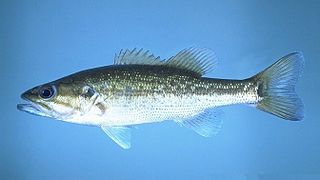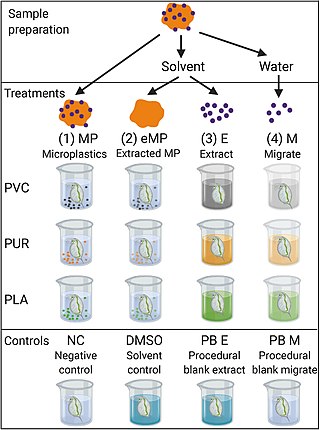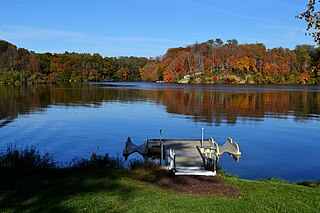
The spotted bass, also called spotty, or spots in various fishing communities, is a species of North American freshwater fish belonging to the sunfish family (Centrarchidae) of the order Perciformes. It is noted for the rows of dark spots below the lateral line, which give it its common name. One of the black basses, it is native to the Mississippi River basin and across the Gulf states, from central Texas through the Florida panhandle. Its native range extends into the western Mid-Atlantic states and it has been introduced into western North Carolina and Virginia. It has also been introduced to southern Africa, where it has become established in some isolated waters as an invasive species.

Lake Marble Falls is a reservoir on the Colorado River in the Texas Hill Country in the United States. The reservoir was formed in 1951 by the construction of Max Starcke Dam by the Lower Colorado River Authority. Originally named Marble Falls Dam, the dam was renamed in 1962 for Max Starcke, the second general director of the LCRA. Located near the city of Marble Falls, the lake is used as a venue for aquatic recreation and for the purpose of generating hydroelectric power. It is the newest and smallest of the Texas Highland Lakes.

The Cape Fear River is a 191.08-mile-long blackwater river in east-central North Carolina. It flows into the Atlantic Ocean near Cape Fear, from which it takes its name. The river is formed at the confluence of the Haw River and the Deep River in the town of Moncure, North Carolina. Its river basin is the largest in the state: 9,149 sq mi.

Lake Koocanusa is a reservoir in British Columbia (Canada) and Montana formed by the damming of the Kootenai River by the Libby Dam in 1972. The Dam was formally dedicated by President Gerald Ford on August 24, 1975.

Fly ash, flue ash, coal ash, or pulverised fuel ash – plurale tantum: coal combustion residuals (CCRs) – is a coal combustion product that is composed of the particulates that are driven out of coal-fired boilers together with the flue gases. Ash that falls to the bottom of the boiler's combustion chamber is called bottom ash. In modern coal-fired power plants, fly ash is generally captured by electrostatic precipitators or other particle filtration equipment before the flue gases reach the chimneys. Together with bottom ash removed from the bottom of the boiler, it is known as coal ash.

Gibbons Creek Reservoir is a power plant cooling reservoir on Gibbons Creek in the Navasota River basin, 20 miles (32 km) east of College Station, Texas, United States. The dam and lake are managed by Texas Municipal Power Agency (TMPA), which uses the reservoir as a cooling pond for a coal-fired power plant generating electricity for the cities of Bryan, Denton, Garland, and Greenville.

Ecotoxicology is the study of the effects of toxic chemicals on biological organisms, especially at the population, community, ecosystem, and biosphere levels. Ecotoxicology is a multidisciplinary field, which integrates toxicology and ecology.

Lake Lafayette is a prairie lake located in the coastal lowland in eastern Tallahassee, Leon County, Florida with US 27 / State Road 20 running close on its south side.

Lake Walter E. Long is a power plant cooling reservoir on Decker Creek in Austin, Texas. The reservoir was officially impounded in 1967 and serves to provide water for turbines used in the production of electricity from petroleum-based fuels. The dam and the lake are managed by the City of Austin. Surrounding Lake Walter E. Long is the city of Austin's Lake Walter E. Long Metropolitan Park, a popular recreational destination.
Meadow Lake is a reservoir on the Guadalupe River south of the town of Seguin in Guadalupe County, Texas. The reservoir was formed in 1931 by the construction of a dam to provide hydroelectric power to the area. Management of the dam and lake was assumed by the Guadalupe-Blanco River Authority on May 1, 1963. Meadow Lake also serves as a venue for outdoor recreation, including fishing and boating.

Calaveras Lake is a reservoir on Calaveras Creek, located 20 miles southeast of Downtown San Antonio, Texas, USA. The reservoir was formed in 1969 by the construction of a dam to provide a cooling pond for a series of power plants, called the Calaveras Power Station, to supply additional electricity to the city of San Antonio.

Victor Braunig Lake, formerly known as East Lake, is a reservoir on Calaveras Creek and Chupaderas Creek 17 miles south of Downtown San Antonio, Texas, USA. The reservoir was formed in 1962 by the construction of a dam to provide a cooling pond for a power plant to supply additional electrical supply to the city of San Antonio. Victor Braunig (1890-1982) was an employee from 1910 becoming in 1949 the general manager of the San Antonio City Public Service Board, the predecessor of CPS Energy. The dam and lake are managed by CPS Energy of San Antonio. Together with Calaveras Lake, Braunig Lake was one of the first projects in the nation to use treated wastewater for power plant cooling. The reservoir is partly filled with wastewater that has undergone both primary and secondary treatment at a San Antonio Water System treatment plant. Braunig Lake also serves as a venue for recreation, including fishing and boating.
The Kesterson Reservoir is part of the current San Luis National Wildlife Refuge in California. Formerly a unit of the Kesterson National Wildlife Refuge, the reservoir was an important stopping point for migratory waterfowl. Kesterson once consisted of 12 evaporation ponds totaling approximately 1,280 acres, and was historically used for agricultural drainage. Kesterson gained national attention during the latter half of the 20th century due to selenium toxicity and rapid die off of migratory waterfowl, fish, insects, plants and algae. The reservoir was closed in 1986, and concentrations of selenium at the site have continued to be monitored throughout remediation efforts.
Baldwin Lake is a 2,018-acre (817 ha) reservoir which spans part of the border between Randolph County, Illinois and St. Clair County, Illinois. The lake is part of the Kaskaskia River State Fish and Wildlife Area, near 38°13′03″N089°52′09″W Elevation: 430 feet (130 m), operated by the Illinois Department of Natural Resources, and it is adjacent to, but not part of, the Kaskaskia River. Its elevation may fluctuate with powerplant operations, but averages 423 feet (129 m) above sea level.

Canton Lake is a freshwater reservoir located in Fulton County, Illinois. It is located east of Canton on Illinois Route 27.

The lake chubsucker is a species of freshwater fish endemic to North America, found in the Great Lakes and the Mississippi River basin, as far north as Ontario, Canada, extending south to the Gulf of Mexico. It is mainly found in lakes, ponds, and swamps, rarely in streams.

The Turtle-Flambeau Flowage is a 12,942 acres (52.37 km2) lake in Iron County, Wisconsin. It has a maximum depth of 15 meters and is the seventh largest lake in the state of Wisconsin by surface area. The flowage is home to unique wetland patterns and plant species as well as several species of sport and game fish, including Musky, Panfish, Largemouth Bass, Smallmouth Bass, Northern Pike, Walleye and Sturgeon. The lake's water clarity is low, but can vary in different locations in the lake. Fishing, camping, boating, and hunting are popular activities on the flowage, and Ojibwe people traditionally harvest fish and game on the lake. Environmental concerns on the flowage include mercury contamination, algal blooms, and several types of invasive species.

In February 2014, an Eden, North Carolina facility owned by Duke Energy spilled 39,000 tons of coal ash into the Dan River. The company later pled guilty to criminal negligence in their handling of coal ash at Eden and elsewhere and paid fines of over $5 million. The U.S. Environmental Protection Agency (EPA) has since been responsible for overseeing cleanup of the waste. EPA and Duke Energy signed an administrative order for the site cleanup.
Lake Athens is a 1,799 acre reservoir located to the east of Athens, Texas in Henderson County.

Powerton Lake State Fish and Wildlife Area is a 1,426-acre (577 ha) area of semi-protected habitat on the Illinois River southwest of to the city of Pekin, Illinois within Tazewell County in the U.S. state of Illinois. The parcel is a cooling reservoir owned by NRG Energy, an electric power generating firm, and is operated by the Illinois Department of Natural Resources (IDNR). The lake is used for fishing, with an emphasis on blue catfish. In addition, IDNR states that approximately 60% of the cooling pond is used for duck and goose hunting during legal hunting seasons. The remaining 40% of the pond is maintained as a waterfowl refuge on a year-round basis.



















